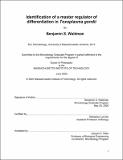| dc.contributor.advisor | Sebastian Lourido. | en_US |
| dc.contributor.author | Waldman, Benjamin S. | en_US |
| dc.contributor.other | Massachusetts Institute of Technology. Department of Biology. | en_US |
| dc.date.accessioned | 2020-09-15T21:54:10Z | |
| dc.date.available | 2020-09-15T21:54:10Z | |
| dc.date.copyright | 2020 | en_US |
| dc.date.issued | 2020 | en_US |
| dc.identifier.uri | https://hdl.handle.net/1721.1/127366 | |
| dc.description | Thesis: Ph. D., Massachusetts Institute of Technology, Department of Biology, May, 2020 | en_US |
| dc.description | Cataloged from the official PDF of thesis. | en_US |
| dc.description | Includes bibliographical references. | en_US |
| dc.description.abstract | Toxoplasma gondii is a parasite chronically infecting over a quarter of the world's population. While Toxoplasma infection is asymptomatic in immunocompetent individuals, it can cause life-threatening disease in immunocompromised patients and the developing fetus. Acute symptoms of infection and dissemination of Toxoplasma throughout the body are due to the rapid proliferation of the tachyzoite stage of the parasite. While tachyzoites can eventually be cleared through adaptive immunity, a subset will differentiate into more slowly replicating bradyzoites. These bradyzoites form intracellular cysts in brain and muscle tissue that cannot be cleared by the immune system or by current therapeutics. Cysts thereby act as latent reservoirs of infection, and periodic reactivation of cysts results in lifelong risk of disease. While differentiation is readily induced in cell culture by diverse stressors, the molecular basis of this conversion is unknown. | en_US |
| dc.description.abstract | I therefore sought to determine the genetic requirements and regulation of bradyzoite differentiation in Toxoplasma. In this thesis, I describe the discovery and characterization of a master regulator of differentiation in Toxoplasma gondii. In my first chapter, I discuss application of CRISPR/Cas9-mediated forward genetic screening in Toxoplasma to identify a Myb-like transcription factor (BFD1; bradyzoite formation-deficient) as necessary for differentiation in cell culture and formation of brain cysts in mice. In my second chapter, I profile replicating and differentiating Toxoplasma in unprecedented detail through single-cell RNA-sequencing, and determine that parasites lacking BFD1 fail to initiate differentiation transcriptionally. In my third chapter, I demonstrate that BFD1 is post-transcriptionally regulated, and that conditional stabilization of BFD1 is sufficient to induce differentiation both phenotypically and transcriptionally in the absence of stress. | en_US |
| dc.description.abstract | BFD1 binds preferentially at transcriptional start sites, including those of many stage-specific genes, and a putative BFD1-binding motif is associated with differential expression. Identification of BFD1 as a master regulator of differentiation is a breakthrough in our understanding of the regulation of chronic Toxoplasma infection, and provides a molecular switch for further characterization of this clinically relevant transition. | en_US |
| dc.description.statementofresponsibility | by Benjamin S. Waldman. | en_US |
| dc.format.extent | 104 pages | en_US |
| dc.language.iso | eng | en_US |
| dc.publisher | Massachusetts Institute of Technology | en_US |
| dc.rights | MIT theses may be protected by copyright. Please reuse MIT thesis content according to the MIT Libraries Permissions Policy, which is available through the URL provided. | en_US |
| dc.rights.uri | http://dspace.mit.edu/handle/1721.1/7582 | en_US |
| dc.subject | Biology. | en_US |
| dc.title | Identification of a master regulator of differentiation in Toxoplasma gondii | en_US |
| dc.type | Thesis | en_US |
| dc.description.degree | Ph. D. | en_US |
| dc.contributor.department | Massachusetts Institute of Technology. Department of Biology | en_US |
| dc.identifier.oclc | 1192495969 | en_US |
| dc.description.collection | Ph.D. Massachusetts Institute of Technology, Department of Biology | en_US |
| dspace.imported | 2020-09-15T21:54:10Z | en_US |
| mit.thesis.degree | Doctoral | en_US |
| mit.thesis.department | Bio | en_US |
